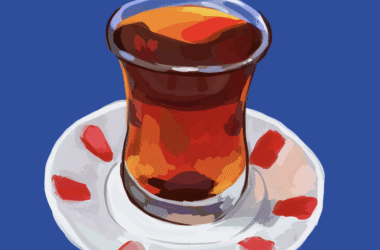The McGill Fight Band doesn’t march. They don’t do halftime shows, they don’t wear Napoleonic uniforms, and they don’t have a dance team. If you’re looking for high-stepping, capes, or colour guards, you’re out of luck. But if you’re looking for spirit, look no further – the growing Fight Band does what fight bands are supposed to do and does it well.
“Every coach comes to my office at least once a week to see if the Fight Band is coming to their game, or to lobby to make sure that they’re coming to their games,” said Jeremiah Gordon, McGill Athletics’s promotions director.
Founded in 2006, the band began with less than a dozen members, but has grown into a robust corps of 40. Boasting woodwinds, brass, and percussion, they’ve become a recognizable presence at varsity games, bringing in bigger crowds and keeping them excited.
Like many great ideas, the band was born at Bar des Pins. Ted Smith, a team manager for the McGill basketball team, had just come back from a summer in Japan.
“Japanese sports fans, and especially baseball ones, are fanatics,” he said. “They organize into a kind of brigade, almost a legion of fans. They bring out bugles and trumpets and small brass instruments and devise fight songs for everybody in the batting lineup to cheer them on. I guess it occurred to me then that it wouldn’t be that hard to do something similar at college.”
When he suggested to his friends at the bar that they should try it, they didn’t take him seriously. The following Monday, he went in to see then-Athletics Director Derek Drummond. Drummond asked him what it would cost and how soon it could happen.
“[I told him], ‘Give me your boardroom to run a couple of informational meetings, give me your photocopier to print off advertisements, and then I’ll need $400 for total expenses,” Smith said.
Drummond agreed. Students were eager to join, but securing practice space proved more challenging: initially, the group practiced late at night in the small music classrooms of a Sherbrooke office building.
“And of course, we had to go get stands,” Smith said. “At around 10, we started gathering up stands from people leaving the practice rooms and hauling them across the street.”
The band played at six games that first year. While some fans were apprehensive about the band’s presence, others enjoyed the injection of spirit, and the band began to grow.
“We started making an impact at games, athletes started to notice us, and then it just kind of grew,” Smith said.
Because members were allowed to drink, Smith admits that the band gained a bit of a reputation for rowdiness.
“Initially, we used to go out and party a lot at the games. At a certain part we had gotten so large that it had potential for a problem,” he said. “We never had any fights or anything like that, but some people questioned the appropriateness of our behaviour as a band [while] wearing McGill uniforms.”
Partly in response to their behavior and partly because of their success, McGill Athletics opted for a closer relationship with the band. The new, more formal arrangement has banned members from drinking during games, but has also given the band more money.
“Their repertoire has improved, their size has gotten better and they’re definitely a great feature that we have now at our varsity sporting events,” said Gordon.
And the band hasn’t completely lost its edge. In addition to playing pep-band standards like “Final Countdown” and “Rock and Roll Part 2” during pauses, the band draws on an impressive arsenal of cheer tactics to pump up the home crowd and annoy the visitors.
“The best games are when we get into other players’ heads,” said Kolya Kowalchuk, U3 music, and also the band’s conductor.
Smith, whose main role in the band’s performances was to get cheers going, recalled some of the ways this worked during his time with the band. For instance, the band might single out a particular player to heckle for an entire game, or play with the other team’s timing.
“When the shot clock was winding down in basketball we would start counting five, four, three, two, one when it hit eight seconds,” Smith said. “I can’t even count the amount of times that worked. Then, once they catch on to that we start, counting from eight [when it hits five seconds], so they’d think they had more time than they did, and that worked, too.”
Band members admit that Fight Band can be a way for ex-high-school-band geeks to relive their glory days, but Smith warned against taking that at face value.
“My impression of band kids has changed considerably since starting this thing,” he said. “When I was in high school I always thought of the band geeks as anti-social and not particularly amusing or skillful … but those kids party hard.”
But the Fight Band is not just a party crew, either.
“What Fight Band has done for a lot of people is create a really comfortable environment, [allowing] them to let loose and make a lot of friends,” Smith said.
Taylor Stocks, U2 political science and the band’s premier, agreed.
“We’re a nice family,” she said. “They’re a group of people you can always count on for stuff, the right combination of nerd and love.”
Though the band’s season is over, they should be back bigger and better next year, and will continue to pump up home crowds and irritate visitors for years to come.






